If you’re in a 12-team three-outfield league, welcome to the deepest position in the game! If you’re in a 15-team league that requires five outfielders, buckle up! It’s difficult to understate just how different outfield feels across those two formats, as there are plenty of interesting options within the top 50-60 at the position, but once you get to around 75 or so (I’d expect around 100 outfield eligible players to be started in a classic 15-team format), things start to dry up quick—especially with playing time.
As with all of the position ranking articles, these blurbs and ranks come from my Top 300 Hitters for Fantasy Baseball 2024 piece that also debuted today! Check that piece out for more on my rankings philosophy and, well, all the rest of my rankings.
Check out the Hacks & Jacks podcast featuring Scott Chu and Joe Gallina, which also happened to be a finalist for Best Baseball Podcast of 2021 by the Fantasy Sports Writers Association (FSWA)!
I also host an AMA in the r/fantasybaseball subreddit every Friday (starting sometime in late March) starting around noon ET that lasts through the rest of the day and into the weekend, so feel free to join the fun and ask questions or make comments.
Tier 1
1. Ronald Acuña Jr. (OF, ATL) – Fun fact, in each season where Ronald Acuña Jr. has played at least 120 games, he’s hit 41 home runs. Sure, that’s exactly two times (2019 and 2023), but the upside is simply that intense. Acuña was already an elite talent, and then in 2023 he cut his strikeout rate in half and turned into a true five-category contributor. Acuña is the hands-down number-one pick in all drafts and all formats.
2. Julio Rodríguez (OF, SEA) – J-Rod put up a 30-30 season with a strong batting average and oodles of counting stats in his sophomore campaign, and while he doesn’t have the upside of Acuña, Rodríguez’s upside is on par with any other hitter in the league. We’ve seen a few lulls here and there, but that’s absolutely normal and fine for a young player getting acclimated to major-league pitching. Seeing him overcome these challenges and return to elite production is the mark of a superstar.
3. Mookie Betts (2B/SS/OF, LAD) – News that Betts will be the everyday second baseman for the Dodgers is fun because it means he’ll retain his most valuable position in all formats for at least another two seasons. The new stolen base rules didn’t help Betts get back to his pre-2020 speed totals, but a career-high 39 home runs and 233 combined runs and RBI with a .307 batting average makes the lower stolen base totals a non-issue. Betts is locked into the top of the order for the Dodgers, and his fantastic plate discipline ensures the ratios and counting stats will continue to pour in. Those in formats where you need 20 starts to gain positional eligibility won’t be able to plug Betts in as a shortstop, but that doesn’t impact his value in any way. Betts is the clear top dog at second base and also near the top in the outfield, and that’s what matters most.
4. Kyle Tucker (OF, HOU) – I’ve never been shy about how much I love Tucker ever since I saw him constantly give pitchers a tough time in his first “full” season in 2020. His 60 combined home runs and stolen bases with over 200 combined runs and RBI should be the norm for this in-his-prime outfielder, and his .294 and .284 batting averages in 2021 and 2023 feel far more like Tucker’s true talent than his .257 in 2022. He doesn’t have the same ceiling as some of the other players in this range, but his remarkable consistency and projected promotion to the actual heart of the Astros lineup suggests yet another fantastic season for the young outfielder.
Tier 2
5. Aaron Judge (OF, NYY) – If Judge plays 140 games, he’s going to hit 45 home runs or more. It’s a given at this point, considering he walloped 37 of them in just 106 games in 2023. The only real concern with Judge is the health, which is a bummer after he spent all of 2021 and 2022 in the lineup. That said, ranking Judge eighth is only happening because of that risk, so don’t take the bait of a “double penalty” and drop him out of this tier in your ranks. The upside is way too high to make that kind of blunder, as there is no better bet to lead the American League (and all of baseball) in home runs than a healthy Aaron Judge.
The addition of Soto to the lineup should also mean more counting stats as the 2023 Yankees were simply dying for a hitter other than Judge (and to a lesser extent, Torres) to help carry their offense.
6. Juan Soto (OF, NYY) – If you’re designing a swing decision model, the best way to test that it works is to see what it says about Soto. If it says he’s amazing, then the model is working. It was great to see Soto hit more home runs than he did in the infamous 2019 rabbit ball season while also getting back to double-digit stolen bases. 2022 was a weird year for him, but the resurgence in 2023 tells us what we already should have known—that 2022 was a fluke.
The most impactful part of the move to New York is the improved home run environment, going from the 10th worst home run park for lefties to the third best. This gives Soto a better shot at finding 40 home runs for the first time in his career if he feels like pulling more fly balls, but I’d say the baseline is still 33-35 home runs with elite ratios. Weirdly enough, Yankee Stadium had the second lowest Expected Home Runs by Park according to Statcast for Soto with 27, tied with Progressive Field and Kauffman Stadium, which are notoriously tough home run parks for southpaws.
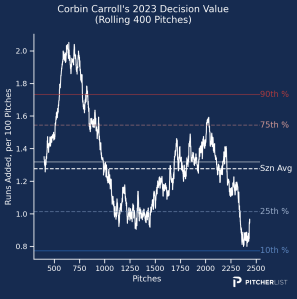
8. Fernando Tatis Jr. (OF, SDP) – Playing in 141 games after missing all of 2022 was a meaningful step towards bucking the injury-prone label we’ve been forced to use with Tatis, and that was the biggest concern I had. Tatis didn’t show us consistent power in 2023 nor did he make strong decisions, but let’s not forget that he was coming off a season where he didn’t play and is going into his age-25 season. The power and speed still look excellent based on Statcast data (even if they weren’t quite what we saw in 2020 and 2021), and there’s top-five upside in Tatis based on what he’s shown us in flashes so far in his career. The loss of Soto could impact his counting stats, though Tatis found plenty of runs scored and RBI back in 2021 so I’m not factoring that too much into this ranking.
9. Yordan Alvarez (OF, HOU) – Talent isn’t the issue here—his career-to-date 162-game average is 43 home runs, 109 runs scored, 128 RBI, and a .295/.390/.588 line. Even with no stolen bases, that’s a Tier 1 player. The issue, of course, is that 162 games is a tall order for a guy with two bum knees. Alvarez managed just 114 games in 2023, though he still managed to hit 31 home runs and drive in 97 runners. You might move him slightly down your board if you took Judge in the first round (yes, you should consider adjusting your board even after your very first pick as you’re no longer “in a vacuum”), or if you’re in a deeper format like the NFBC where the replacement level is very low, but in shallower standard formats you needn’t hesitate to scoop up this husky slugger.
Tier 3
10. Michael Harris II (OF, ATL) – Harris II rebounded nicely after the famously slow start to the season. It was so bad that I nearly dropped him off my top 150, though I’m glad I thought better of it as he put up yet another batting average over .290 with almost 20 home runs and exactly 20 stolen bases. It was good to see Harris finally get out of the nine-hole and start hitting closer to the middle of the lineup, which should have an immensely positive impact on his so-far lackluster counting stat totals, and the sub-20% strikeout rate is a credit to his excellent hand-eye coordination and contact ability. Harris is highly unlikely to start taking many walks, but his quick bat and athleticism give him 25-25 upside with a high batting average and improved counting stats.
11. Adolis García (OF, TEX) – The power is very real and I expect his 27 home runs from 2022 to be a true floor for 2024, though the lack of steals from García in 2023 is a bit of a bummer considering the improved stolen bases across the league. This downturn is likely a combination of factors—he’s slowing down physically (he’s dropped from 93rd percentile speed when he debuted in 2018 to 49th percentile speed in 2023 according to Statcast), he had a new manager that isn’t known for being overly aggressive (steals were down for multiple Rangers in 2023), and also he now has a significantly improved lineup ahead of him with the additions of Seager and Semien. I’m not expecting most of those missing steals to return as each of these factors is likely to continue in 2024, but García’s raw power and strong supporting cast (that should get even better as Carter and Jung develop) should make the floor high enough to keep him among the top 30 hitters with a ceiling that’s inside the top 20.
12. Luis Robert Jr. (OF, CWS) – We finally got the full season we’ve been hoping for, and the power and speed did not disappoint as he put up 68 combined home runs and stolen bases. No one should be questioning LuBob’s upside, but there’s plenty of room to question the floor. The strikeout rate rolling chart is one that deeply concerns me as it suggests this new elevated strikeout rate may be here to stay, and it is very difficult to find consistency with a strikeout rate that hovers around 29%—especially when a guy already deals with volatility and health issues. By talent, Robert should be in Tier 3, but the number of red and yellow flags means he’s best for team builds that already have some stability at the top.
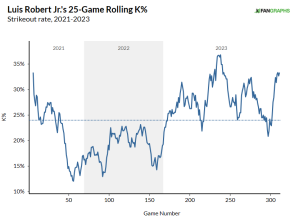
13. Randy Arozarena (OF, TBR) – We’ve got a pretty good sense of what Arozarena is at this stage of his career—a 20-home run, 20-stolen base guy who should have a decent batting average and plenty of counting stats by the end of the season, though the journey will be rough at times due to his volatile swing-decision tendencies. It’s well worth weathering the storms when they pop up, and I’m curious whether the downturns will be more manageable thanks to an improved walk rate he showed in 2023.
Tier 4
14. Kyle Schwarber (OF, PHI) – Two seasons in Philly, two straight seasons of setting career highs in home runs (46 in 2022, 47 in 2023). It comes with a .200 batting average, unfortunately, but he’s second in home runs, seventh in runs scored, and ninth in RBI in all of baseball since the start of 2022. If you’re intentionally punting batting average or are in an OBP league, you could argue he’s in Tier 3.
15. Bryan Reynolds (OF, PIT) –While I hoped that there’d be a bit more of a ceiling for Reynolds, he’s now put up three straight seasons of 24 or more home runs and has finished 14th, 24th, and 20th in the outfield in those campaigns. Counting stats are tougher to come by for Reynolds than other similar outfielders already on this list due to the fact he plays for the Pirates, but the floor is so high that it’s not too tough for me to squeeze Reynolds into my top 40.
16. Jazz Chisholm Jr. (OF, MIA) – If healthy, Jazz could be a 30-30 type of player and could also give us improved counting stats if the Marlins continue to find good pieces for their lineup. Of course, health has been quite fleeting for the shortstop-turned-outfielder as he’s missed 205 games over the last three seasons. In addition, Jazz has a troubling 29.2% career strikeout rate and hasn’t given us any signs that it will change. The upside is indisputable, but the floor is incredibly low.
17. Mike Trout (OF, LAA) – He’s still Mike Trout, folks. Yes, he’s missed a lot of time over the past three seasons and wasn’t exactly a picture of health before then either, but his 134 wRC+ over 82 games in 2023 was the lowest single-season mark he’s posted in the big leagues since his 40-game campaign in 2011 (his rookie season). Being 34% better than average is bad for Mike Trout. Let that sink in. If I already had steals wrapped up with earlier picks, I might consider moving Trout up over guys like Jazz and Hoerner.
18. Christian Yelich (OF, MIL) – Yelich appears to have figured out his chronic back issues after years of struggling and it led to his best season since 2019 as he hit 19 home runs, scored 106 runs, and swiped 28 bags with a .278 batting average and .370 OBP. The stolen bases might come down just a bit due to the aging curve, but another season with close to 20 home runs and 25 stolen bases is certainly in the cards, and the healthier back should help keep those ratios up a little higher than years past as well.
Tier 5
19. Nolan Jones (1B/OF, COL) – Jones was quite good for most of his 2023 debut (besides July), but he turned it on in September, posting a 16.4% walk rate, 21.1% strikeout rate, and a .349/.461/.651 line with seven home runs and 46 combined runs and RBI. The 21.1% strikeout rate is what stands out to me in this line, as Jones’s power was a known commodity from his prospect days, and landing in Colorado made it even more likely that his power would play to some degree. If Jones can take a step forward in his decision-making against breaking balls, we could see a new gear to his game that looks more like his September line, but I’m guessing we don’t get quite that good of a result. I’m thinking something like 25 home runs, another 20 stolen bases, and a volatile (but not necessarily bad) batting average with good-not-great counting stats on a bad Rockies offense.
20. Cody Bellinger (OF, FA) – It was a second breakout for Bellinger in 2023 as he set career bests in strikeout rate, batting average, and stolen bases while putting up his most productive season since 2019. These dramatic turnarounds are hard enough to process on their own, but when they come with a career-worst barrel rate, hard-hit rate, and average exit velocity, it’s nearly impossible. I can’t ignore the actual results, but the concerning underlying numbers leave me quite skeptical that Bellinger can repeat without actually changing what he is as a hitter—something we aren’t asking anyone else in the top 40 to do.
21. Josh Lowe (OF, TBR) – Lowe started hot, got very cold, and then was hot again, which makes projecting for him a frustrating endeavor. I think the 20 home runs seem about right based on his minor league track record and scouting grades, and the Rays are so aggressive on the base path that 32 stolen bases are certainly attainable. The strikeout rate is the number to watch, as the prolonged slump for Lowe was closely tied to strikeout issues over the summer. Lowe was never a good decision-maker at any point in 2023, but he did manage to improve his ability to make contact against lefties towards the end of the season and also against breaking pitches (see below), and if that continues then we can expect another strong season. If he regresses with the contact against breakers, though, it could be a bumpy ride with a low floor.

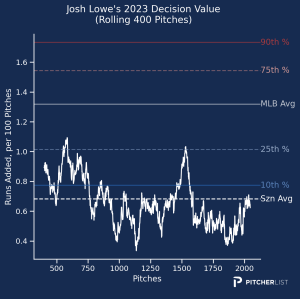
22. Anthony Santander (OF, BAL) – Santander is unlikely to surprise us in 2024, but the improved Baltimore offense means his 30 home runs and .250 batting average should come with close to 100 RBI. He won’t steal many bases, but his floor and ceiling are pretty close together, making Santander an excellent choice for those who have already taken a few gambles on offense.
23. Nick Castellanos (OF, PHI) – The strikeout rate went up fairly significantly (27.6%), continuing a trend that’s been going on for the last few seasons, but the production returned after Castellanos’s deeply disappointing 2022. There were ups and downs in 2023 (like May and July) that will make the floor a little bit scary, but the power is still there and he’ll continue to play every day for the Phillies so strong counting stats and 25 or more home runs should be there even if the batting average takes a tumble due to the strikeouts and inconsistency.

24. Teoscar Hernández (OF, LAD) – It was a bumpy ride at times, but the free-swinging Hernández hit his way into a solid season in Seattle that saw him finish as a top 25 fantasy outfielder and top 60 fantasy hitter. Teoscar’s aggressive approach leaves him incredibly prone to hot and cold streaks, and those streaks defined his 2023 for me as he repeatedly oscillated between being a must-start and a must-sit sort of player.
Landing in Los Angeles with the Dodgers is an improvement in virtually every way—Dodger Stadium is extremely friendly to right-handed power (126 home run factor is tied with Great American Ballpark for the highest in baseball), and even though he’ll hit considerably lower in the order than he did in Seattle, Teoscar should have no issue getting to yet another 90 RBI season. Batting seventh makes it hard to score a bunch of runs, but we saw guys like Rosario and Ozuna bat in the bottom half of the order for much of the season and they showed it’s possible to get to 75 runs down there given enough playing time in a bombastic offense.
25. Jorge Soler (OF, FA) – It was Soler’s best season since the rabbit-ball era of 2019 thanks to good health, a career-high fly ball rate, a significantly reduced pop-up rate, and one of the best season-long strikeout rates of his career. Soler continues to hit the ball exceptionally hard on a very consistent basis, so he’s certain to find a team that wants him to play every day.
The keys to Soler’s 2024 will likely be team context (ballpark, supporting cast, etc.) and whether he can stay healthy after missing huge chunks of time in multiple prior seasons. If Soler wasn’t heading into his age-32 season with a long injury history, I’d likely have Soler at least one or two tiers higher than this. He could also jump if he signs with a powerful offense (like the Dodgers).
26. Brandon Nimmo (OF, NYM) –Nimmo finished just inside the top-70 hitters last season thanks to a significant power boost tied to an elevated fly ball rate and also a career-high in plate appearances. He hit the ball harder as well, raising his average exit velocity by over two ticks. There’s still some risk on the injury front as Nimmo enters his age-31 season having missed significant time in 2017, 2019, and 2021, but if you believe the almost one-to-one ground ball to fly ball rate will stick in 2024, then Nimmo should be moved up a tier. I’m a bit skeptical about that, but not so skeptical that I’m uninterested in Nimmo in 12-team leagues.
27. George Springer (OF, TOR) – Springer just put up his first ever 20-20 season at age 33, and while durability and age are negative factors to his value, he did put up a second consecutive season with at least 133 games and has at least 20 home runs in each of his last seven full seasons (even his injury-shortened 78-game season in 2021). Springer will be on top of a Blue Jays lineup that disappointed in 2023 and should rebound in 2024. 25 home runs, 15 stolen bases, and a .250-.260 batting average feel like a good baseline if he plays a full season, despite his advanced age.
28. Seiya Suzuki (OF, CHC) – Suzuki is now two-for-two in slow starts and strong finishes here in the US, and in each case, we have at least a somewhat compelling reason for the slow start (adapting to the US in 2022, and coming back from injury in 2023). A Suzuki that doesn’t start poorly and stays healthy could probably hit 25 home runs, steal 10 bases, and slash .280/.360/.485, and I’m willing to buy into that upside at least one more time.
Tier 6
29. Lane Thomas (OF, WAS) – Thomas exceeded my expectations for him in just about every category, and in the case of home runs and steals, he did it by almost double. While his quality of contact did improve to a degree and he did start pulling the ball significantly more, it doesn’t explain the improved numbers. If it did, our Pitcher List expected stats (which take into account batted ball direction) would show something better than a .237 xAVG and .446 xSLG. While I do think a 20-20 season is within reach and accept that none of his numbers seem especially dubious, I’m still a bit skeptical that Lane Thomas can wind up in the top-50 hitters. Top 60 or top 75 should be doable, though, and his floor should keep him from falling out of the top 100 overall (which is not true for many hitters in the tier below).
30. Riley Greene (OF, DET) – Greene’s injury, which forced him to miss more than a month of action, could not have come at a worse time as he was absolutely on fire at the time, hitting .365/.435/.573 last May before going down. Greene’s power and speed aren’t overwhelming for fantasy, but I still believe he can get to 20 home runs and double-digit steals with an excellent batting average if he stays healthy with the upside to do even more.
31. Jackson Chourio (OF, MIL) – After signing an 8-year $82 million contract, Chourio is all but guaranteed to be on the Opening Day roster. Chourio ranks as one of the game’s top prospects and has an incredibly high fantasy ceiling. This past season, he hit 22 home runs and stole 44 bases between Double-A and Triple-A. He showed noticeable improvements to his contact skills helping ease some of the worries for his transition to the Major Leagues. He projects as a 24/45 player at his ceiling and could easily post 15 home runs with 30+ stolen bases this year.
Here is what Martin concluded in our composite article from November:
“Chourio is a no-brainer elite prospect. His power/speed blend is virtually unmatched and he’s just 19.”
32. Evan Carter (OF, TEX) – After breaking out during the 2022 season, Carter continued his impressive offensive performance in 2023. Standing at 6’4”, Carter packs plenty of raw power in his swing which is aided by his elite plate discipline. Carter made his Major League debut on September 8 and produced some massive swings helping the Rangers capture their first World Series title. He is not going to post a 180 wRC+ again, but he should be a reliable contributor for both the Rangers and dynasty managers in 2024.
Carter was excluded from our composite article in November due to already having made his Major League debut. However, Matt Heckman wrote a piece on hitters with small samples in December that you can check out here.
33. Jarren Duran (BOS, OF) – The trade of Verdugo makes Duran the obvious pick to lead off for Boston, a role he excelled in last season as he hit .319/.350/.547 with 25 runs scored and 23 extra-base hits while going 12 for 13 in stolen base attempts over just 36 games. Injuries and inconsistency threw his train off the tracks at times, but a healthy Duran is more than capable of hitting 15 home runs and stealing 30 bases in 2024. He’s missed time with injury in two of the last three seasons and had two particularly brutal cold stretches in May and August, but Duran is more than worth taking a chance on in the middle rounds of a draft.
34. Ian Happ (OF, CHC) – Happ gets a boost in OBP leagues thanks to his double-digit walk rates, but even in standard leagues his 20-22 home runs and 12-15 steals should make an impact, especially since they come with over 80 runs and 80 RBI as long as he’s healthy and the Cubs can look anything like the 2023 version of themselves. Happ is mostly just an accumulator who provides everything except batting average, and if you’re in a deeper league or are at a place in your draft where you need a safety net in the outfield, Happ is your guy.
35. Spencer Steer (1B/3B/OF, CIN) – Steer’s first full season in the big leagues went far better than anyone could have expected, with 23 home runs, 15 steals, and 160 combined runs and RBI with a .271/.356/.464 line. His average tailed off towards the end of the season, in part because pitchers started to challenge him less with hittable pitches (particularly breaking balls), but Steer responded well by showing he could make contact with the more difficult pitches.

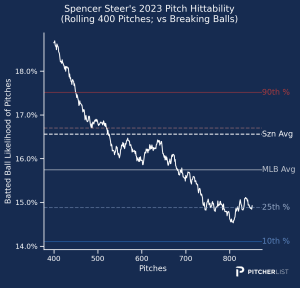
36. Masataka Yoshida (OF, BOS) – Yoshida’s season probably felt worse than it was to those who rostered him due to the complete collapse of his power in August and September. He hit just two home runs over his final 33 games, and part of his descent was likely related to his increased aggression and worsening decision-making as the season wore on. On the plus side, while his contact ability faded it stayed safely above average and that tool plus some lessons learned over the offseason could lead Yoshida to 20 home runs, double-digit steals, and a batting average that flirts with .300. If it doesn’t, the floor should be high enough to keep him near or around the top-100 hitters unless the bottom completely falls out.
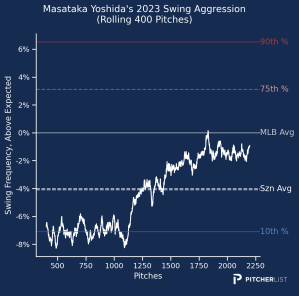
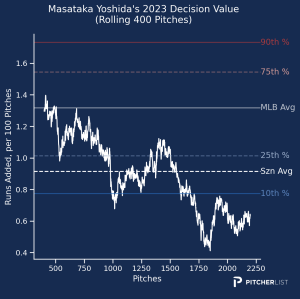
37. Cedric Mullins (OF, BAL) – With Henderson usurping the leadoff role from Mullins, the range of outcomes for the speedy outfielder is now much wider than in years past. Mullins finished well outside the top 100 hitters in 2023 thanks to a poor batting average, injuries, and then being forced into a platoon to end the season.
Mullins will get another shot at full-time plate appearances in 2024, though it will likely be lower in the order than in 2021 and 2022 (maybe sixth or so) and the leash will be short due to the up-and-coming outfield talent Baltimore has in the minor leagues. If Mullins can solidify his role in the lineup, there should be a path to 20 home runs and 30-35 steals that would put him inside the top 50. If he isn’t able to get into a groove, though, there’s the risk that he will post yet another finish outside the top 100, and possibly even outside the top 150.
38. MJ Melendez (C/OF, KCR) – Melendez finally turned it on towards the end of the season, hitting .286 with eight home runs over his last 44 games. Counting stats won’t be easy to come by in Kansas City, but there’s enough raw power in his bat that Melendez could get to 20 or more home runs in his everyday role and score 80 runs. The batting average won’t be better than .240, but in leagues where he’s still eligible at catcher, there’s plenty of value. As just an outfielder, Melendez falls at least 20-30 spots.
39. TJ Friedl (OF, CIN) – It was a breakout campaign for Friedl as he was able to stay healthy and with the big league club for a (mostly) full season’s worth of plate appearances. Friedl dramatically outperformed his expected stats in 2023, beating his Baseball Savant xwOBA by 63 points and his Pitcher List xwOBA (which includes batted ball direction) by 57 points with most of the difference coming in his power numbers. That kind of overperformance makes me doubtful that Friedl can replicate his 2023 performance in any category besides runs scored (as he projects to lead off for the Reds).
A more realistic baseline would probably be 15 home runs, 80-90 runs scored, and 20-22 steals, with a significant drop in ratios that are more likely to resemble the .240/.314/.436 he posted in 2022, which is far more inline with what his expected stats have shown at the major league level.
40. Eloy Jiménez (OF, CWS) – Health continues to evade Eloy as he played in just 120 games in 2023. From a talent perspective, he should be a .280+ hitter who hits 30 home runs and drives in 90 runners regularly, but the sheer number of injuries he’s suffered over the last three seasons makes that kind of projection much harder to imagine. Jiménez’s upside keeps him in my preseason top 100, but I’d need to feel pretty good about my power and consistency in the outfield to consider drafting him where he’ll likely be going.
41. Christopher Morel (2B/3B/OF, CHC) – Morel is still without a regular position due to his subpar defensive skills, but his raw power suggests he could hit 30 or more home runs in a season if he managed to make contact on a more consistent basis. Morel’s strikeout woes are well-documented, though, and his decision-making skills declined as the season went on (see below). The low contact ability means Morel needs to make good decisions at all times, and until he can pull that off, he’ll remain an extremely volatile player.
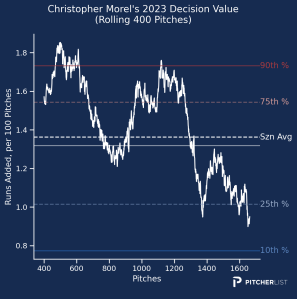
42. Jordan Walker (OF, STL) – The highly-hyped prospect didn’t have the debut we hoped for, but to be fair, a 116 wRC+ as a 21-year-old is nothing to sneeze at. A demotion to the minors in May and summer slump were disappointing (and not entirely his fault), but it was good to see Walker rebound late in the season, slashing .302/.376/.497 from August 9 to the end of the season that very importantly included almost as many fly balls as grounders. I was encouraged by that growth because it’s the secret to unlocking his power potential, and also by the fact that Walker was not at all phased by major league breaking balls—a very common issue that you’ll hear me talk about throughout these rankings. 2024 could very well be the breakout year for Walker.
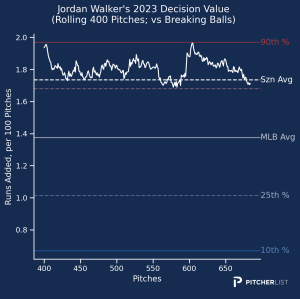
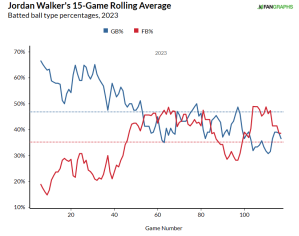
43. Lars Nootbaar (OF, STL) – Injuries once again limited Nootbaar to fewer than 120 games in the big leagues, but he still managed to show the power, speed, and on-base skills that caught our attention in 2022. Nootbaar looks like a good fit for the top third of the lineup, and if he can seize that opportunity, we could be looking at 23-25 home runs, 150-160 combined runs and RBI, 13-15 steals, and solid ratios. Those are all dependent on health and lineup position, though, and Nootbaar has yet to show consistency with either, but the upside is very real.
Tier 6
44. Kerry Carpenter (OF, DET) – Carpenter is a power-first outfielder who could hit 30 home runs in a full season, though his vulnerability to left-handed pitching makes him a platoon risk. I think the batting average will be around .260 and he’ll get plenty of counting stats when in the lineup, so all that’s left is for him to start in 140 or more games to exceed this ranking.
45. Lourdes Gurriel Jr. (OF, ARI) – If you read the Hitter List over the last two seasons, then you know that I struggle to know what to do with Gurriel. The dizzying highs and terrifying lows we get from him throughout a season make Gurriel a player you can’t merely plug into your lineup and forget about, and the ups and downs don’t correlate with standard splits (like righty/lefty or home/away).
Gurriel enters 2024 as a free agent, and while he certainly could hit 20-25 home runs with a .270 average (this would be a high-end projection for sure), his wide range of outcomes has me pushing him down my list unless he lands in an ideal situation somehow.
46. Chas McCormick (OF, HOU) –McCormick was another player I was very skeptical of last season due to his poor zone contact rate and his inflated line drive rates around the middle of the season, but to his credit, McCormick continued to produce (albeit to a lesser extent) when the line drive rate started to return to normal, hitting nine home runs and stealing eight bases over his last 50 games.
McCormick truly shines against lefties, posting a 177 wRC+ against them in 2023 and a 163 wRC+ against them over his career while being merely average against right-handed hitting. That weakness to righties caps McCormick’s upside a bit, but his strong defense and 2023 breakout should help him eclipse 120 games played for the first time in his big league career while giving him a path to a 20-20 season. The batting average is a question mark and any prolonged slump could lead to a platoon, but as long as he’s in the lineup the power and speed should be there.
47. Taylor Ward (OF, LAA) – The decision-making went from average to incredible in 2023, and Ward showcased a strong ability to make contact with flashes of above-average power. Injuries and inconsistency foiled him for a second consecutive season, but like Vaughn, I’m willing to get back on the saddle one more time to see if we can get a .275 average with 25 home runs along with 160 combined runs and RBI. I think the ceiling is as good or better than Vaughn’s, but I also admit that the floor is lower.
48. Steven Kwan (OF, CLE) – Few players can boast the bat-to-ball skills that Kwan has, but he’s struggled to make a big fantasy impact with that hit tool. Kwan has just 11 home runs across two full seasons, and this number is unlikely to improve based on what we’ve seen.
The skills are there to give Kwan a ceiling that includes a .300 average, 100 runs scored, and 30 stolen bases, but when you have the lowest hard-hit rate and the third-worst barrel rate in baseball, your path to fantasy relevance requires a lot of things to go your way. Kwan finished 2023 outside the top-100 hitters, and if the Guardians’ offense flounders again or if Kwan continues to be capped at 20 steals by his manager, or if he has rough batted ball luck, or if he loses his hold on the leadoff spot, it could happen again. In points leagues or deep formats that value the high number of plate appearances, Kwan should be moved up multiple tiers.
49. Esteury Ruiz (OF, OAK) – NFBC players will take Ruiz a lot earlier than this due to the fact he’s almost certain to lead the AL in stolen bases after swiping 67 bags in 2023, but keep in mind that Ruiz fell short of 50 runs scored and 50 RBI and that the .254 batting average and .309 OBP are just about as good as it’s going to get due to his aggressive approach and complete lack of power. He will steal a boatload of bases and not hurt your ratios that much, which is not super valuable in head-to-head categories formats, but those in roto leagues will probably have him in a tier or two above this.
50. Daulton Varsho (OF, TOR) – It was a disappointing first season in Toronto as he fell short of expectations in almost every category. A big part of the explanation is the 19% pop-up rate, the second-worst mark in the league and almost double the rate he posted in 2022. Our PLV metrics indicate he was incredibly aggressive against fastballs to start the season, though it improved as the season went on which is also reflected in his decision value against those fastballs (though it’s worth noting that his pop-up rate was worse at the end of the season, so decision-making against fastballs didn’t cause that specific problem).
Varsho should be a 20-20 outfielder in Toronto and his counting stats should improve naturally by rebounds from Guerrero Jr. and Bichette, though the batting average will stay in the basement unless he makes better decisions against fastballs and/or cuts down on the pop-ups.
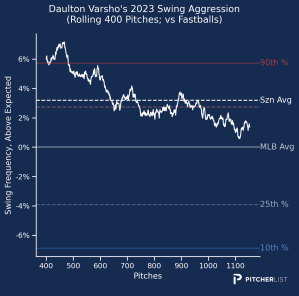
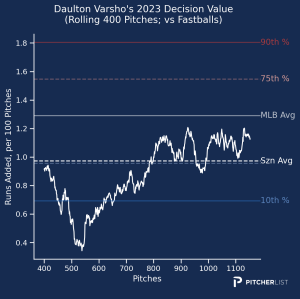
51. Starling Marte (OF, NYM) – Injuries loom large for Marte as he enters his age-35 season but in just 86 games he managed to steal 24 bases in the new environment for the Mets. I’d advise against projecting Marte for more than 110-120 games, but the upside even in that short time could be 10-15 home runs and over 30 steals. That kind of upside is hard to come by at this stage, and in shallow leagues, it makes Marte worth scooping up near the end of the draft.
Tier 7
52. Alex Verdugo (OF, NYY) – Verdugo was exceptionally average last season as he saw his batting average fall to a middling .264 after five straight seasons hitting at least .280, but a move to the Bronx and a presumably better lineup should hopefully squeeze more juice out of the contact-oriented outfielder. Additionally, if LeMahieu struggles at all in the leadoff spot, Verdugo would probably be the next man up to take that role in front of Judge and Soto, and it wouldn’t be hard to imagine Verdugo piling up a ton of runs scored in that role.
53. Tyler O’Neill (OF, BOS) – Another year, another rash of injuries and poor performance from O’Neill despite possessing plus power and speed. O’Neill enters 2024 as hyped as he’s ever been now that he’s been traded to a Red Sox team that doesn’t have any significant threat to his playing time (other than O’Neill’s own body). Fenway could be a boon to O’Neill’s power numbers as it provides an even greater incentive to pull the ball. Additionally, the chart below shows growth in his decision-making that could help him keep that double-digit walk rate and lowered strikeout rate in 2024. The extreme injury risk and erratic performance in the last few seasons make it hard to rank him higher, but if you want potential, there’s evidence there to support its existence.
As a caveat, those in deeper formats who can’t easily replace an outfielder should move O’Neill down your list by at least one or two tiers, if not more. This ranking only works in standard 12-teamers because whiffing on an outfielder at this stage of the draft doesn’t do any long-term damage.
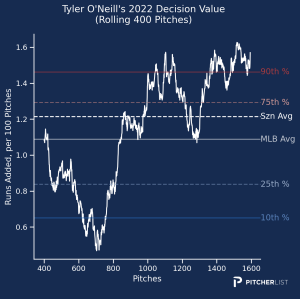
54. Matt Wallner (OF, MIN) – Wallner has a difficult path to a full-time role due to the nature of the Twins roster and his weakness to left-handed pitching, but there’s no doubting his raw power after he hit 14 home runs in 76 games. Keep Wallner in the back of your mind, especially in OBP formats, when you need power at the end of a deep draft or during the season when perusing the wire, but even if Wallner is healthy for all of 2024, it’s unlikely he gets to 120 games played while in a strict platoon.
55. Jeff McNeil (2B/OF, NYM) – McNeil is essentially Arraez-lite. He puts a ton of balls in play, rarely strikes out, and scores runs. He doesn’t do those things quite as well as Arraez, but McNeil does them consistently. McNeil is slightly more likely to get to double-digit home runs and steals, but 10 is pretty close to the cap for him in both categories.
56. Jarred Kelenic (OF, ATL) –A surprise trade lands Kelenic in Atlanta, a team who just got more out of Olson, Ozuna, and Rosario than I ever thought possible at this point, so it’s safe to say things are looking up for the maligned outfielder. Kelenic never found his groove with the Mariners in the majors due to strikeout issues, but he continued to rake every time he went back to Triple-A. At his prospect peak, Kelenic was viewed as a perennial 20-20 threat who could also hit for average. Atlanta is likely to start Kelenic in a platoon due to their crowded roster and Kelenic’s spotty history against southpaws, but if you want to throw a high-upside dart later in the draft, Kelenic’s upside is as high as anyone’s.
57. Max Kepler (OF, MIN) – Kepler is tough to appreciate in 12-teamers as he lives right around the replacement level most of the time, but his second half in 2023 certainly caught my attention as he put up a .926 OPS with a .306 batting average. Kepler has been unable to handle left-handed pitching for most of his career, though.
58. Tommy Pham (OF, FA) – The veteran outfielder is coming off his most productive season since 2023 as he looks to find work with what could be his fifth team in three seasons. It’s difficult to pinpoint specific reasons for his improved stat line other than the new stolen base environment, and it’s not easy to think of a team that’s going to be willing to give a 36-year-old free agent a chance to bat cleanup like they did in Arizona last season, but Pham could work his way to 15 home runs and 15 steals if given an everyday opportunity.
59. Bryan De La Cruz (OF, MIA) – De La Cruz was a boring yet reliable back-end outfielder last season, finishing just inside the top 50 at the position thanks to his 78 RBI and high volume. If De La Cruz can stay in the top five or six spots in the order, we should see something like a repeat of his 2023 line, though the counting stats may take a step back as he’s not likely to get 41 games hitting third unless a few injuries pop up.
60. Brendan Donovan (2B/OF, STL) – Remember the stuff I said about McNeil? That all applies to Donovan except for the fact that Donovan has missed almost half of 2023 with an elbow injury and also is at risk of landing on the large side of a platoon if he continues to slug under .300 against left-handed pitching. He should provide solid ratios against righties with double-digit home run power and a little bit of speed, but there’s a lot of playing time risk that comes with it.
61. Parker Meadows (OF, DET) – Meadows’ 22 home runs and 27 stolen bases across the majors and minors last season were exciting, particularly for action-starved Tigers fans like myself, but Meadows’ hit tool will likely limit his contributions to something closer to 15 in each category, assuming he gets a full season of plate appearances. His willingness to take a walk should give him a leg up on the leadoff spot in Detroit, so if Meadows continues to walk more than 10% of the time and keeps that strikeout rate around 25% or lower, he could provide 80 runs and sneak his way into the top 150 hitters.
62. Kris Bryant (OF, COL) – Over his first 32 games, Bryant hit .300/.387/.467 with five home runs and things looked like they’d finally work out for him in Colorado. Unfortunately, nothing went right for Bryant after that as he had two IL stints that lasted over a month each and posted a pitiful 40 wRC+ in the games he did play in over the rest of the season. Entering his third year of a seven-year deal, Bryant has only appeared in 122 games, but the first chunk of 2023 combined with his short yet strong 2022 still leaves a tiny morsel of hope that he could be a top 40 outfielder, though it comes with huge injury and performance risk.
Tier 8
63. Wyatt Langford (OF, TEX) – There might not be another prospect in baseball with more hype than Wyatt Langford. Langford dominated professional pitching after being drafted by the Rangers in the first round of the 2023 MLB Draft. Langford looks like the complete package and is already banging on the door of the major leagues. The reason he ranks in Tier 8 on this list is that the Rangers do not have a clear opening for him on their roster. Evan Carter, Leody Tavares, and Adolis García profile to be the Opening Day starters for Texas making it likely Langford will start in Triple-A. Langford also only has 44 professional games under his belt.
Here is what Steve concluded about Langford from our composite article:
“Langford projects as a power-over-hit prospect with good speed but has shown that all can be elite tools. To avoid projecting Langford as a top 10 MLB player, I would expect 30 home runs, and 15-20 steals with a .270 average as he begins his career. These numbers still put Langford at the top of the league and will be a fun kid to watch paired with Evan Carter in the Rangers outfield.”
64. Giancarlo Stanton (OF, NYY) – Stanton hits the ball unbelievably hard and misses a lot of games. It was true before, and it’s true now. The only real change in his game is that between the strikeouts, the fly-ball-heavy approach, and the loss of speed, Stanton is an extreme drag on your batting average and OBP. He only needs about 110 games to hit 30 home runs, but even getting that many will take some luck.
65. Sal Frelick (OF, MIL) – Frelick doesn’t have much in the way of power (his career single-season high is 11 home runs across three levels in 2022), which makes the fact that the Brewers hit him fourth so often in 2023 quite the surprise. Milwaukee’s relatively thin roster means Frelick is currently slated as the third or fourth hitter in this lineup heading into 2024 behind Yelich and Contreras, and if that holds then Frelick could be a candidate to drive in 80 runners with double-digit home runs and stolen bases. He’s likely not much more than barely above replacement level in 12-teamers, but those in deeper leagues or points leagues may get more mileage out of his low strikeout rates and ability to put the ball in play.
66. Brent Rooker (OF, OAK) – Rooker was a home run machine at the beginning and end of the season, but in between those outbursts was a brutal 69-game stretch where he struck out in 35.2% of his plate appearances and slugged just .358. Rooker struggled to make good swing decisions with two strikes on him, and his poor zone contact skills suggest this kind of volatility will continue to be part of his game. The home run total may very well be over 30 in 2024, but you’ll probably only want to roster him for about 50-60% of his plate appearances to get maximum value.
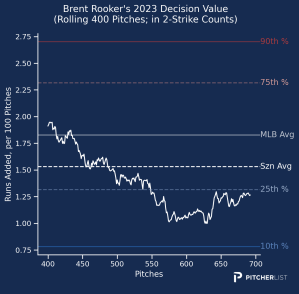
67. Henry Davis (OF, PIT) – He’s not catcher-eligible during your draft, but Davis should get the position eligibility back within the first few weeks of the season (as early as the second week in Yahoo leagues), and his 20 home run power upside isn’t the worst thing in the world to gamble on. I would be surprised if a healthy Davis fell short of 130 games played between catcher, DH, and outfield, and that kind of playing time should help Davis be a streamable catcher in most formats, and even a viable second catcher in leagues that require two. He’s being a bit overlooked in drafts, but I think that will change as we get into the spring.
68. Leody Taveras (OF, TEX) – Tavares should find a way to get to 15 home runs and 15 steals in 2024 if he stays healthy as he fell only just short of those marks in 2023. I don’t think there’s much upside for more than that and Tavares is likely to stay buried at the bottom of the Texas lineup, so as long as your counting stat expectations are low, you won’t be disappointed.
69. Austin Hays (OF, BAL) – It’s unlikely that there’s another level to his game, and most of his value comes from hitting fifth and playing a lot. The primary issue with Hays is that when he’s bad, he’s exceptionally bad, such as the 24-game stretch shortly after the All-Star Break where he hit .172/.215/.241.
70. Gavin Lux (2B/OF, LAD) – Lux missed all of 2023 with a knee injury he suffered shortly before the start of the season, but returns in 2024 with the keys to the starting shortstop job. Once a top-five prospect, our expectations for Lux have fallen dramatically after 273 very average games (for fantasy purposes) to start his career. I suppose you can see 15 home runs and 10 steals if you squint a bit, but Lux’s only bankable value comes from his strong plate discipline which should lead to a .270 batting average and .350 OBP.
71. Andrew Benintendi (OF, CWS) – Two straight seasons of hitting just five home runs suggests the power outage is here to stay, but expect the White Sox to keep Benintendi at the top of the lineup in 2024, giving him a chance to score 70 runs or so and steal 10-15 bases with a decent batting average. He won’t provide anything else that’s helpful, but at least it ain’t nothing.
Tier 9
72. Jung Hoo Lee (OF, SFG) – Lee has excellent contact skills that should help ease his transition to state-side professional baseball. He is locked into a regular role on the Giants which gives him obvious value for 2024. San Francisco does not profile as an ideal home ballpark for his power metrics, but fantasy managers can count on him posting a valuable batting average in 2024.
Lee was not included in the composite write-up from November, but Jake Maish wrote an excellent piece detailing his dynasty value which you can check out here.
73. Luis Rengifo (2B/3B/SS/OF, LAA) – The super-utilityman Rengifo started walking a lot more than he had in 2021 and 2022, but other than that, it’s hard to imagine him being more than the 16-18 home run hitter with decent ratios that he’s been for the last two seasons. You’ll probably pick up Rengifo at various points in the season when dealing with injuries or when he’s heating up, but you don’t need to draft him in a format that includes a waiver wire.
74. Nelson Velázquez (OF, KCR) – Velázquez made waves once he was traded to the Royals, hitting 14 home runs in 40 games, though it came with a 29.3% strikeout rate and a .233 batting average. That more or less tracks with what we expected of him as a prospect, making him a lower batting average guy with a 25-30 home run upside. Some power hitters can get by with a low-walk approach (like his teammate Salvador Perez), but he’ll likely need to cut the strikeout rates to find any real consistency.
75. James Outman (OF, LAD) – Outman’s poor zone contact numbers early in the season led to an ugly slump that saw him hit the waiver wire in most standard leagues, but there were signs of optimism late in the season as he steadily improved his contact ability. Fastballs, in particular, were a huge weakness for Outman when it came to contact despite the fact he was excellent at making the correct swing decisions against them. On the bright side, Outman did get better at connecting with fastballs, and more growth could certainly happen.
Whiffing on strikes is a big red flag to me, as that can be more indicative of a talent problem than a mental problem, Outman’s power does present enough upside to keep me intrigued for 2024, just not as one of my first three outfielders.
76. Alex Kirilloff (1B/OF, MIN) – Kirilloff’s hit tool and power could make him a valuable first baseman or outfielder in fantasy, but the injuries have never stopped piling up, allowing other players to get a chance to steal his spot in the lineup. If given the chance to play 120-140 games, Kirilloff could provide a .270 batting average with 17-19 home runs and decent RBI totals, but between a roster logjam and ever-present injury concerns, it’s hard to imagine Kirilloff getting that chance.
77. Mark Canha (OF, DET) –The upside is limited for the 34-year-old southpaw, but Canha is still an elite decision-maker who should play 140 games while batting somewhere in the first five spots in the lineup for a major league lineup. Double-digit home runs should be there, and he did steal 11 bases in 2023. I think the Tigers offense will be better than projections are suggesting, so don’t be shocked if Canha also finds a way to drive in 75 runners.
78. Pete Crow-Armstrong (OF, CHC) – Traded back in 2021 for Javier Báez, Pete Crow-Armstrong’s athletic abilities have been on full display. He is a talented defender which should give him a bit of grace as his bat develops at the major league level. His debut last season did not go well as he went hitless in 19 plate appearances. His 20 home runs and 37 stolen bases in the minor leagues speak to his upside as a fantasy asset. The concerns over his hit tool prevent PCA from ranking higher on this list.
79. Alek Thomas (OF, ARI) – There still could be 15 home runs and 15 steals in Thomas’s future, but it’s locked behind a career 56.8% groundball rate in the majors that wasn’t much better in the minors. Players can and do fix this issue, but it’s not easy nor common for the change to stick long-term.
80. Jakob Marsee (OF, SDP) – Marsee has the opportunity to earn the starting center field job in Spring Training this year. He put together an impressive first full season of professional baseball hitting 16 home runs with 46 stolen bases. There are questions over how well his power will translate to the major league level, but there is OBP and stolen base upside apparent. He should find himself in San Diego at some point during the first half and be a valuable fantasy asset once he arrives.
Here is what Matt wrote about Marsee back in November:
“Marsee is still incredibly underrated. The biggest question mark is his power, but a .280 hitter, who walks 12% of the time and can steal 35 bases only needs to hit about 15 home runs to be fantasy-relevant. His advanced approach makes him one of the safer prospects to target and there is a strong chance we see him debut in 2024.”
81. Andrew McCutchen (OF, PIT) – If your league has swagger as a category, move Cutch up several tiers. Few players in baseball are as fun to root for as McCutchen, and while he doesn’t have the speed or power he did in his prime, his elite decision-making skills and a chance to play almost every day in the heart of a lineup means there are a lot of ways Cutch finishes in the top-175 hitters, if not the top-150.
Tier 10
82. Jake Fraley (OF, CIN) – 15 home runs and 21 steals over 111 games should get me more excited, but between the crowded roster, his extensive injury history, and his team’s complete unwillingness to let him face left-handed pitching, I think 2023 represents Fraley’s realistic ceiling. It has great value over shorter periods, but he’s unlikely to be on rosters for a full season outside of deep formats.
83. Stone Garrett (OF, WSH) – Garrett won’t be ready to go on Opening Day, but his .271/.335/.477 line in 116 career games is worth waiting for in deep leagues as it comes with 17-20 home run upside if he plays in 130 games. He’s struck out a lot (30.7% of the time), but he seemed to get better at making stronger decisions as 2023 progressed.

84. Jesús Sánchez (OF, MIA) – Sanchez has a lot more power than his 14 home runs in 2023 would suggest, as evidenced by his 46.3% hard-hit rate. The issue for Sanchez comes from his decision-making, particularly on pitches outside of the zone. Those bad decisions often lead to bad contact, leaving Sanchez with a ground-ball rate near 50%. Until he can consistently pick the right pitches to swing at (and therefore drive more balls in the air), we won’t get to see the raw 25 home run upside that currently lies dormant in his bat.
85. Michael Conforto (OF, SFG) – I’d like to think that there’s another big power season in Conforto’s bat, but two straight seasons of slugging .384 make it tough to hold out too much hope. Conforto opens the season as the regular DH for the Giants, and his high walk rate and low strikeout rate make the floor pretty safe, especially in OBP leagues. There’s a chance he spikes another 20+ home run season, but don’t get your hopes too high.
86. Charlie Blackmon (OF, COL) – He only played in 96 games last year, but Blackmon still showed the ability to provide solid ratios (.279/.363/.440) with 15 home run pop (8 in just over half a season). There’s nothing too exciting here, and I’m not sure I start him on the road, but Blackmon remains a streamable option in most formats.
87. LaMonte Wade Jr. (1B/OF, SFG) – Wade Jr. was finally mostly healthy for a season, and he returned decent value (good value in OBP leagues) with 17 home runs and 64 runs scored. Wade Jr. should hit near the middle of San Francisco’s lineup, though the quality of that lineup makes it hard to project more than 110-120 combined runs and RBI to go along with 16-18 home run power. The floor is high, but the ceiling is fairly low.
88. Mitch Haniger (OF, SEA) – Haniger has lost two straight seasons to injury (just 114 games played in 2022-2023), but he did hit 39 home runs for Seattle back in 2021. Would it be that weird if Haniger stayed healthy and hit 25 home runs with maybe a .240 batting average? Well, yes, but not that weird.
89. Will Benson (OF, CIN) – Apart from a 31.3% strikeout rate, and a wRC+ of 3 against lefties (not a typo, he was 97% worse than average players against same-side pitching), there was a lot to like about Benson’s 2023 season. The crowded Reds roster makes a full-time role all but impossible to imagine for Benson, but as a platoon player, he can certainly get to 15 home runs and 15 stolen bases. The .275 batting average will almost certainly come down to something more like .230-240 due to his zone contact issues and some normal luck regression, but he’ll be very streamable throughout the season.
90. Brenton Doyle (OF, COL) – 10 home runs and 22 steals in 126 games ain’t too bad, and the Rockies are likely to give Doyle a full season as their center fielder in 2024. He achieved these numbers despite posting a mind-blowing 19 wRC+ in Coors Field last season, which I have to think is some kind of fluke. If Doyle is even close to average at home in 2024, he’ll be a popular streamer in those games.
91. Luke Raley Jr. (1B/OF, SEA) – 19 home runs and 14 steals is nothing to sneeze at, but Raley’s issues with left-handed pitching and strikeouts make it hard to see a path to a consistent role. It also doesn’t help that Raley lost his fire down the stretch, hitting .196/.272/.366 with a 35.2% strikeout rate in his final 36 games. I would guess that he platoons with any number of bench guys near the bottom of Seattle’s lineup, and that’s far less appealing than his previous situation.
92. Harrison Bader (OF, NYM) – You can’t project Bader for more than 110 games, but even in that short amount of time he should hit a couple of home runs (up to 10, I’d guess) and steal 20 bases with bad ratios. That has a certain utility in some formats, and his hot streaks will land him on even some 12-team rosters for a few weeks. He’d be a 15 home run plus 30 stolen base threat if he played anything close to a full season, but he hasn’t done that since 2019.
93. Hunter Goodman (1B/OF, COL) – Goodman has a boatload of power and what appears to be an everyday role in the Colorado outfield, which means that he’ll be interesting whenever the Rockies are at home (which, of course, is 81 times). The ratios on the road will be too much to bear for most managers, but Goodman could very well finish with a .250 batting average and 25 home runs.
94. Seth Brown (1B/OF, OAK) – Brown should hit 25 home runs if he plays a full season, but he’ll do so with minimal counting stats for a full-time player and also will hurt your ratios. That’s useful in deeper formats and his volume will keep him relevant there, but shallow leaguers should look for more upside.
95. Wilyer Abreu (OF, BOS) – Abreu can hit the ball hard and run a bit, as shown by his 24 home runs and 11 steals in 114 games across Triple-A and the majors last season, plus he should be able to hit for a decent average thanks to his elevated line drive rates. Playing time is a bit of a question mark, though, as he may sit out against lefties with Bobby Dalbec and Rob Refsnyder on the roster.
96. Brandon Marsh (OF, PHI) – The ceiling and floor are pretty close together with Marsh, as he’ll likely hit somewhere around .260 with 10-15 home runs and 10-15 stolen bases. I’m a little bit intrigued about the spiked walk rate in 2023 (12.5%, almost double his totals from 2021 and 2022), as it could lead to more stolen bases and make him a viable fifth or sixth outfielder in OBP leagues, but otherwise, there isn’t much to see here besides a strikeout rate that makes him fairly streaky.
97. JJ Bleday (OF, OAK) – I’ll let the charts tell the story, but I am curious about whether Bleday can hold on to this power along with his decision-making to overcome his limited contact ability.

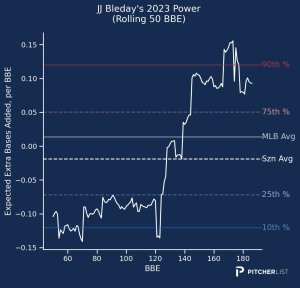
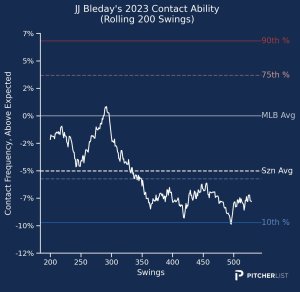
98. Whit Merrifield (2B/OF, FA) – Landing place and role will play a big part in how we rank Merrifield. If he lands somewhere that he will be given the chance to hit near the top of the lineup with a manager who likes to steal bases, Merrifield had a chance to be a top-150 hitter. If he goes somewhere that wants him to hit near the bottom of the lineup with a manager who is conservative on the base paths, then he could fall outside the top 200. I am projecting the latter.
99. Colton Cowser (OF, BAL) – The fantasy community seems to be down on Cowser after a disappointing major league debut last season. While his struggles at the major league level are relevant, fantasy managers should not ignore his 136 wRC+ at Triple-A. This is a talented prospect with plus power and a strong hit tool. Baltimore’s crowded lineup prevents him from ranking higher on this list.
Here is what Martin wrote about Cowser back in November:
“There are so many things to love about Cowser’s future. I think the bat is excellent and I believe in the skills. There are no reasons to think he cannot make adjustments and figure out off-speed pitching at the next level. Once he settles in, we are looking at an All-Star caliber player for many years to come.”
100. Ramón Laureano (OF, CLE) – A healthy Laureano can still hit 15 home runs and steal 15-20 bases, and if healthy the Guardians are all but forced to play the 29-year-old outfielder (I could have sworn he was much older) regularly. The ratios will be ugly, but double-digit power and speed and a clear path to playing time aren’t easy to find down here.
Photo by Julian Avram/Icon Sportswire | Adapted by Justin Paradis (@JustParaDesigns on Twitter/X)
